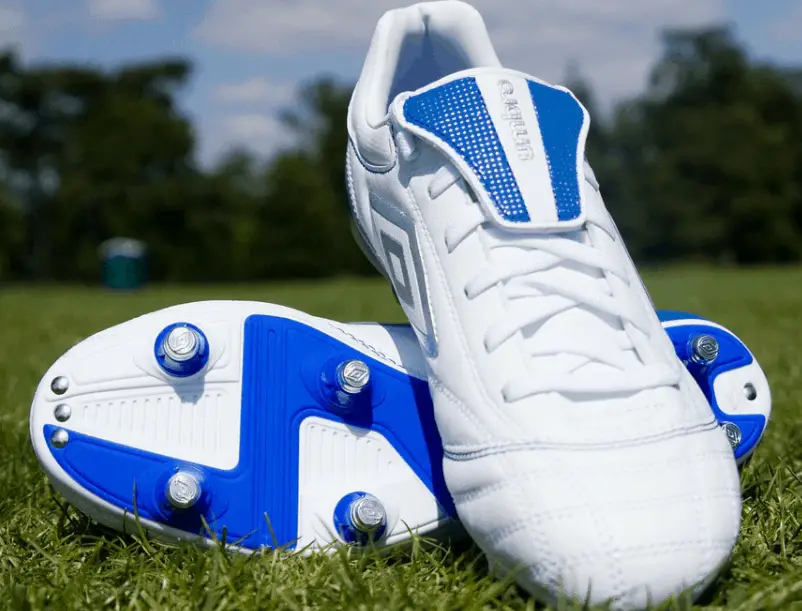Is there a difference between football and rugby boots? It is a perfectly valid question, when many sports shops don’t display a line of rugby boots. So, can you wear football boots to play rugby in? Do your kids, or yourself, need a separate pairs for each sport? Let’s tackle this issue head on by outlining the difference between football and rugby boots.
Rugby boots are designed with the need for power and stability in mind, whereas football boots are made with speed and agility in mind. This means that rugby boots are typically: wider, have a raised heel, have more and larger studs, and have a higher cut around the ankle.
Rugby boots compared to football boots
| Rugby Boots | Football Boots |
| Low/mid/high cut options around the ankle Wider soles A raised heel 21mm studs height 10mm stud width minimum Backs: 6 studs (4×2 layout) Forwards: 8 studs (6×2 layout) Denser outer layer Typically weigh: 250 grams/pair | Low cut around the ankle Narrower soles Contoured to the foot more 8-16 mm stud height Tighter fit Lighter overall weight 6 studs (4×2 layout) Typically weigh: 220 grams/pair |
Furthermore, there are a few more nuanced areas to bear in mind as well. In rugby, players that play in the backs often wear football boots because their positions requires a great deal of agility and kicking as well.
This is why football boots are popular with rugby players. You can read about why there is so much kicking rugby here and about the different types of rugby kick here.
This is not true so much for rugby forwards whose needs are very different. Imagine the weight and power that is forced through the heels of a front row forward in a scrum. It is essential, therefore, that they have a firm base to push from, hence the wider boots with more and larger studs than soccer boots.
Many forwards also prefer protection for their ankles with a higher cut level around the ankles which helps reduce injuries from being kicked or stamped on in that area.
You will also notice that rugby boots are less contoured to the foot and the material surrounding the foot is generally slightly bulkier, once more providing valuable protection.
The boot pictured below is a popular junior rugby boot made for rugby forwards. Note the high ankle cut, width and general bulk of the boot. You wouldn’t want to play football in them that’s for sure!
An Instore Test of Rugby V Football Boots
An interesting test you can do when you go into a sports shop next is to pick up a pair of football boots and rugby boots and then twist the boot length wise. You’ll find that the rugby boot is much more rigid than its footballing counterpart.
Furthermore, you will notice the same if you bend the boots across the toes too, imagine the difference that rigidity makes when you are scrummaging!
A further unique design element of rugby boots is the raised heel. Typically, the heel is given a boost of around a centimetre in height compared to the front of the boot. This is said to increase the power a player can generate and it also takes pressure off the achilles tendon and calf muscles during scrums.

Recommended for you: Why Rugby Is Sometimes Called Football
Stud Arrangements
Interestingly, football boots generally have 6 studs arranged with two at the front and 4 at the back. This helps keep their weight down to aid with speed and agility. In contrast rugby boots generally have 8 studs with 2 at the back and 6 at the front.
Rugby studs are up to 21mm in length and football studs vary in length but are typically around 15 mms enabling players to ‘glide’ above the surface rather than dig and grip into it as rugby players prefer.
Personally, I wear 21mm studs in the back 6 studs and then shorter studs at the front. I find 21mm studs at the front tend to trip me up and hamper my agility somewhat and this simple change seems to make a decent difference.
I also prefer to buy rugby boots made by rugby specialists, such as Canterbury, or Gilbert, I just trust the name and believe in their specialised products more.
Minimum Stud Width: Rugby v Football
There is a crucial point to be made here though, the minimum width of a stud in rugby is 10mm but some football boots including boots with blades may be narrower than that, in which case they are illegal in rugby and should not be worn. You might want to read our Rugby Boot Rules Made Simple article here.
The reason studs need to be 10mm or wider is that much less than that and they are becoming sharp objects in their own right, never mind any extra fraying that they may incur. The Nike chevron blades are a case in point here, they are just too thin to be safe in rugby.
That said, it always comes down to the matchday referees individual opinion and enforcement of the issue on the day.
If you already have a pair of football boots that you want to wear for rugby but are worried the studs are too small, then you may well be able to unscrew them and screw in studs that are legal in rugby so all is not lost.
Some manufacturers don’t provide studs to general retail stores which is annoying and you may have to order direct from the manufacturer to find compatible studs of a larger size, again Nike is an example of a company that do this.
One point of note is that these rules for rugby boots exist for a reason and that is to keep players safe. Imagine, picking up your child from training or a match and they have bad scratch marks down their legs, face or wherever.
Firstly, you are going to be concerned about your child and secondly, you are going to be pretty upset that the club did not prevent this fairly foreseeable injury.
Furthermore, imagine you pick up your child from training and are told that they have accidentally seriously hurt another player because they were wearing non-compliant football boots to play rugby in. It would not be a nice position to be in.
Finally, a bit of common sense is of course needed with this. Rugby boots and football boots are very similar. In fact, I would suggest that up until the forces involved become much greater, at around the 15 years of age mark, then a decent pair of football boots would suffice to play rugby in.
However, when the weight and speed are ramped up, then rugby boots that are more capable of dealing with the unique pressures of rugby are going to be a much safer bet for you, and/or your child.
Recommended: How Much Do Rugby Players Earn
A Word On Moulded Boots
On firmer grounds, 4G pitches, or simply by player preference on any pitch, rugby players (usually backs) may prefer to wear molded stud boots much like footballers do.
They are perfectly within the rules of the game provided they are wide enough, but the studs on molded boots do have a tendency to wear and become sharp over time. Not such an issue in football but a problem in rugby.
The problem is that the moulded studs cannot be replaced and so you may be looking at having to buy a new set of boots. You might be able to fix the issue with a bit of handy work with a sharp knife to provide a fresh edge to the affected studs but who wants to be hacking away at their studs pre-match.
At the risk of stating the obvious though, do run your hand down the sole of your boots and check for frayed edges (burring) and any sharp edges that may have developed.
You can then deal with these before they become an issue, or cause any damage. Just to round this article off then, let’s round this topic of with an FAQ:
Also read: How To Clean Rugby Boots?
What is special and different about rugby boots?
Rugby boots are special and different because of their focus on stability and power. The raised heel, wider soles, 8 stud base, and denser outer layer set them apart from football boots. Different positions in rugby would also wear slightly different boots and these can also be modified slightly for soft and firm grounds.
For example, a front row forward would want the higher cut around the ankle, 8 studs and wide soles. However, a winger might want to wear boots cut around the ankle and with just the 6 studs to minimise weight and increase running speed but also to prevent their feet from digging in the ground so deeply on each step.
It is largely a case of personal preference and with half an eye of the rule book. I hope you found this helpful, you might also want to read: What rugby players wear.

